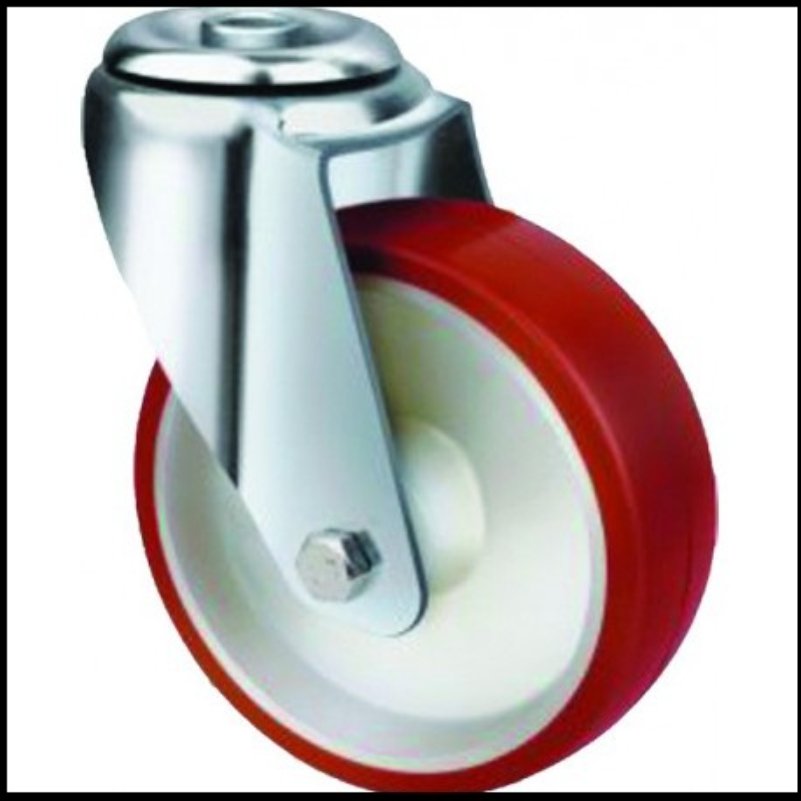In principle we use the castor as a mechanical assembly that allows us to replace sliding motion with rolling motion, often with an inbuilt turning mechanism to allow both smooth forward movement as well as smooth changes of direction. To best industrial castorsestablishment, it is useful to consider ubiquitous castor in its elements and to identify the characteristics of those elements as well as the consequences of their interactions. We use the following international standards, nomenclature and characteristic descriptions to aid our customer recommendations.
Thread count
The tread is the outer surface of the wheel, i.e., the part that comes in contact with the ground. It can be carved with smooth or raised patterns to increase its grip on the ground.
Outer cover
The casing, or rolling strip, is the outer ring. It is made of different materials and characterizes the appearance of the wheel. The covering is fixed when attached to the wheel centre body as a single solid piece (using adhesive or by mechanical connection) or when mechanically assembled to the wheel centre body.
Wheel centre body
The wheel centre body is the part of the wheel that connects the covering to the bore. It comes in different shapes and is made of different materials; It can be one piece or two or more parts joined together.
Bore and rolling actions
The bore is the central part of the wheel that contains the axle or bearing surfaces that facilitate rotation (ball bearings, roller bearings, plain bearings, etc.)Based on construction methods and casing materials, wheels can be divided into three families: rubber wheels, polyurethane wheels, and monolithic (or solid tread) wheels.
Rubber wheels
Rubber wheel coverings consist of elastomers made from natural and/or synthetic rubber. The rubber used to make Industrial castors Wheels can be vulcanized or injection moulded.
Vulcanized Rubber: Special mineral loads and vulcanizing agents are added to the rubber which undergoes a process called "vulcanizing". During this process, the molecular structure of the rubber changes significantly: at the beginning of the process, the "pasty" material becomes a non-fusible product that acquires and, over time, maintains the form of the mould in which the reaction takes place. The resulting ring is mechanically assembled into the wheel centre body. Vulcanized rubber has enhanced elastic deformation properties over a relatively broad range of applied traction and compression loads.
Mechanical characteristics of industrial castors
The mechanical characteristics of vulcanized rubber vary depending on the quality of natural and/or synthetic rubber used, the type and amount of mineral load added, and the conditions under which the vulcanization process takes place.
Injected Rubber: Rubber undergoes a process of chemical synthesis. The source material is injected into a mould into which the wheel centre body has already been inserted. Injected rubber retains its functionality even after moulding.
These parameters are not independent; In other words, changing one of them usually changes the other parameters (to varying degrees). Hardness is the easiest parameter to determine: in general, increased hardness reduces elastic properties (impact strength, ultimate elongation, compression set) and reduces overall wheel performance. Instead, parameters such as tear resistance and friction loss depend mainly on the composition of the vulcanized rubber and, to a lesser extent, on the hardness.
Polyurethane wheels
Polyurethane wheel coverings consist of elastomers derived from the synthesis of raw materials. Polyurethanes are chemical compounds obtained from a polymerization reaction induced by the mixing of two components, belonging to two different families of compounds (di-isocyanates and polyalcohol’s), previously heated to a temperature that renders them a liquid with a relatively low viscosity. keeps in position. Generally, elastomer polyurethanes contain no additional mineral loads. The reactive mixture is poured or injected into hot moulds containing metal or plastic centres.
Where to Buy Leister in Austr...
Environmental Stress can affec...
How Custom Home Builders Creat...
Secure Global Synchronized FX ...
Everything You Need to Know Ab...
Discover Transformation at Our...
Family-Friendly Winter Activit...
Kinima Physio - The Go-To Clin...
Is Your Old Car Just Sitting T...
The Ultimate Guide to Home Bui...

